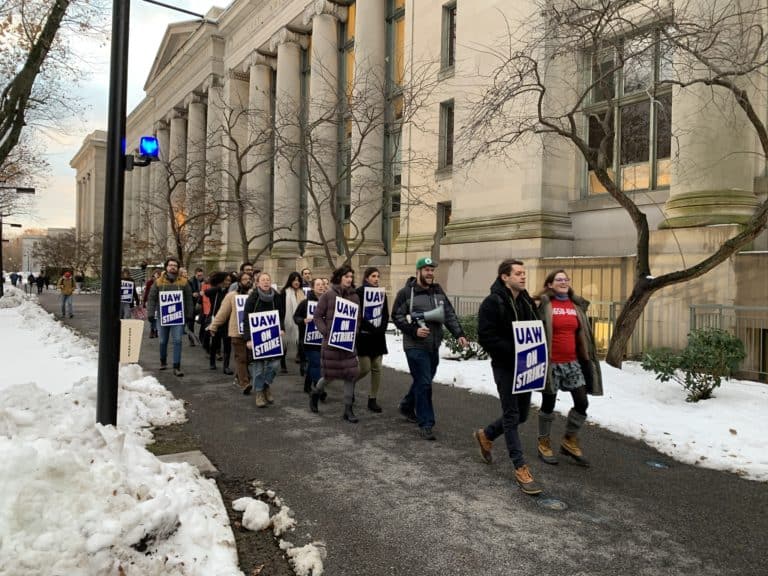Lydia DePillis at the Washington Post synthesized yesterday’s opening statements in McDonald’s high-stakes case before an administrative law judge at the NLRB in New York. The case—over whether McDonald’s is a “joint employer” liable for its franchisees’ alleged labor law violations—has been 3.5 years in the making. It arose out of hundreds of complaints from McDonald’s workers, who alleged that their employers retaliated against them for protesting for higher wages. In its opening statements, NLRB lawyers argued that McDonald’s is a “joint employer” that “substantially controls the lives of cooks and cashiers who work in its franchised locations.” Lawyers also demonstrated the extent of the corporation’s control over its franchisees, describing McDonald’s training of franchise owners and managers, extensive manual that specifies how each store should be run, and standard enforcement through deployment of “operations consultants.” Lawyers for McDonald’s pushed back, questioning not only the NLRB’s evidence but also the “motivations” of the NLRB’s general counsel in bringing this case. They accused the general counsel of acting on his belief that franchising is a “bad business model for union organizing” and also argued that “everything McDonald’s does to improve its franchisees’ performance is essential to maintaining the brand, which a franchisor is allowed to do without becoming a joint employer.” McDonald’s lawyers also warned that a joint-employer finding would disincentivize franchisees from being in the business without a system that “allows them to be their own boss.” The hearing will continue next week.
Two major unions have thrown their weight behind United Continental Holdings, which is currently waging a proxy battle over effective control of the company’s fifteen-member board. The Wall Street Journal reported that the International Association of Machinists, which represents 28,000 United ground workers, and the Association of Flight Attendants, which represents 24,000 United cabin-crew employees, both expressed its support for CEO Oscar Munoz, who is now returning to full-time work after months on medical leave. Both unions have voting representation on United’s board, which has had labor representation since the mid-1990s.
As the New Jersey Transit (NJT) and its unions failed to reach an agreement with only two days left before a potential rail strike, major New York businesses began making strike contingency plans. According to the New York Times, Mount Sinai Health System—which operates seven hospitals and employs 4,000 New Jersey and Pennsylvania residents—planned in-hospital sleeping arrangements for staff that could not go home and return in time for their next shift. Meanwhile, Macy’s was arranging for some of its New Jersey–residing employees to report to the department store’s New Jersey locations, rather than commuting into New York. The NJT’s contingency mass transit plan would accommodate only thirty-eight percent of the 105,000 New Jersey residents who commute daily into New York City via rail. One business advocacy group estimated that “each hour of delays caused by a strike could cost the city’s businesses $5.9 million.” If NJT rail workers, who have not had a contract since 2011, went on strike this Sunday, it would mark the first NJT rail strike in thirty-three years.
With fewer-than-expected Americans filing for unemployment benefits last week, national jobless claims fell to the lowest point it has been since October 2015. Reuters reported that this five-month low indicates sustained labor-market strength and should allay fears of a recession, which were triggered by a “recent massive stock market sell-off that caused a tightening in financial market conditions amid slowing global growth.” Despite the financial-market volatility, the U.S. job market remains strong, with 242,000 new nonfarm jobs added in February and the unemployment rate holding at 4.9 percent.






Daily News & Commentary
Start your day with our roundup of the latest labor developments. See all
November 27
Amazon wins preliminarily injunction against New York’s private sector bargaining law; ALJs resume decisions; and the CFPB intends to make unilateral changes without bargaining.
November 26
In today’s news and commentary, NLRB lawyers urge the 3rd Circuit to follow recent district court cases that declined to enjoin Board proceedings; the percentage of unemployed Americans with a college degree reaches its highest level since tracking began in 1992; and a member of the House proposes a bill that would require secret ballot […]
November 25
In today’s news and commentary, OSHA fines Taylor Foods, Santa Fe raises their living wage, and a date is set for a Senate committee to consider Trump’s NLRB nominee. OSHA has issued an approximately $1.1 million dollar fine to Taylor Farms New Jersey, a subsidiary of Taylor Fresh Foods, after identifying repeated and serious safety […]
November 24
Labor leaders criticize tariffs; White House cancels jobs report; and student organizers launch chaperone program for noncitizens.
November 23
Workers at the Southeastern Pennsylvania Transportation Authority vote to authorize a strike; Washington State legislators consider a bill empowering public employees to bargain over workplace AI implementation; and University of California workers engage in a two-day strike.
November 21
The “Big Three” record labels make a deal with an AI music streaming startup; 30 stores join the now week-old Starbucks Workers United strike; and the Mine Safety and Health Administration draws scrutiny over a recent worker death.